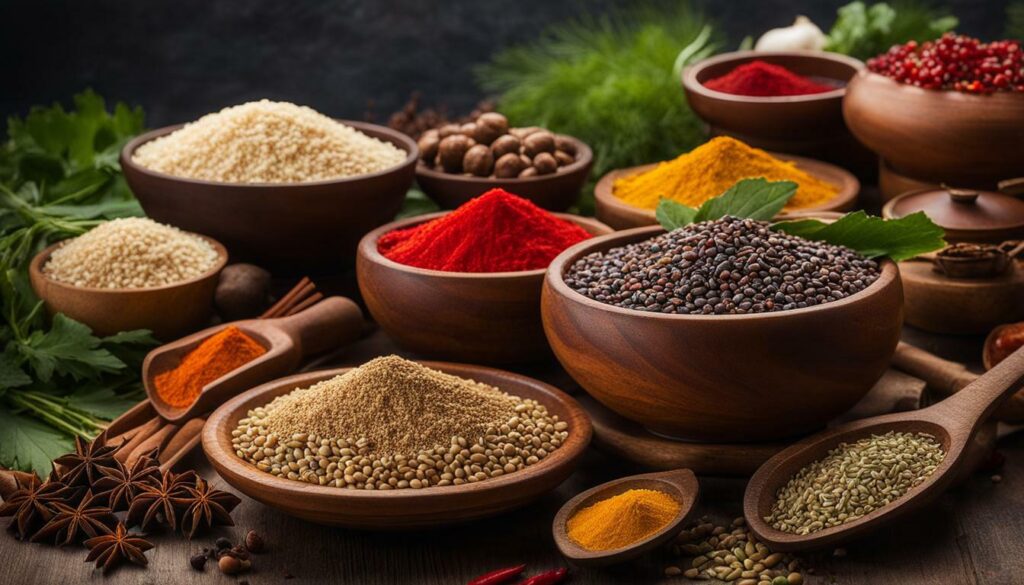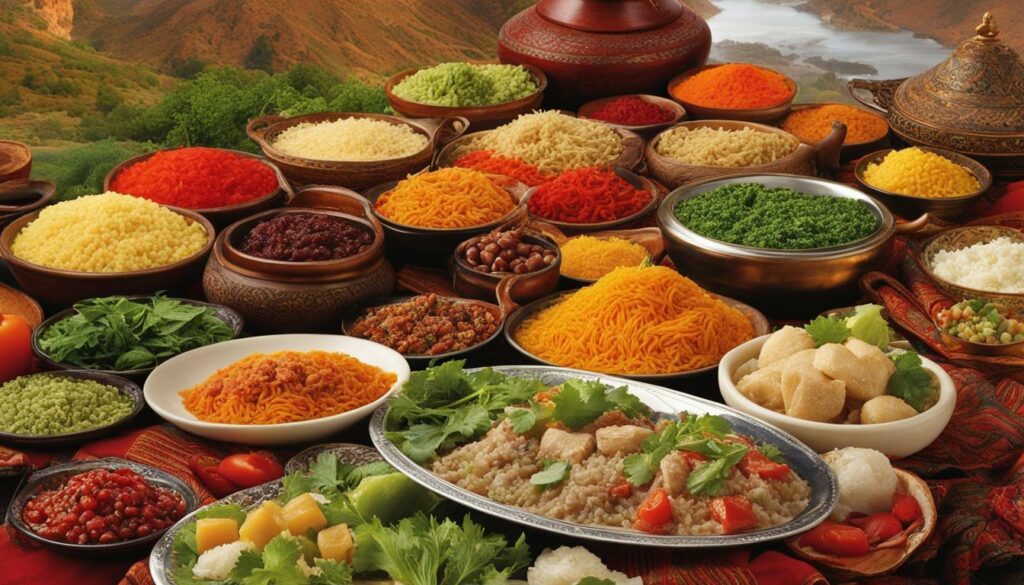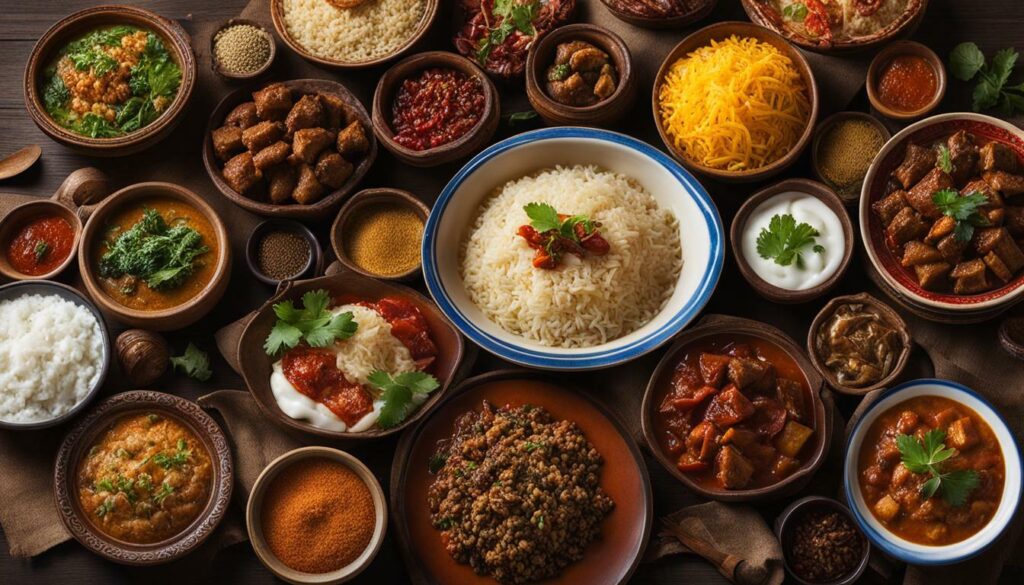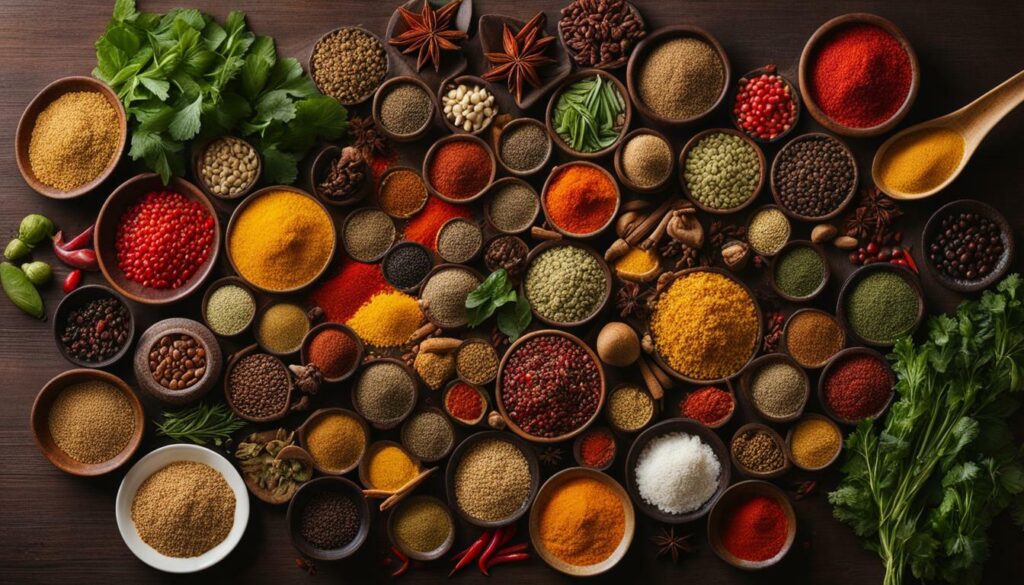Key Takeaways
- The ancient exchange routes, such as the Silk Road, played a significant role in shaping the food culture of Central Asia, introducing a variety of grains, fruits, legumes, and nuts.
- Food in Central Asia serves as an identity marker, reflecting diverse cultural influences and traditions throughout history.
- Central Asian nomads relied heavily on livestock products like milk and meat, supplemented by grains and fermented products like koumiss.
- Staple foods in Central Asian diets include grains, dairy products, and various types of meat, providing essential nutrition.
- Modern-day Central Asian cuisines demonstrate a fusion of traditional and contemporary elements, influenced by globalization and local culinary traditions.
The Ancient Exchange Routes and Culinary Influences
Central Asian diets have been greatly influenced by the ancient exchange routes that crisscrossed the region, particularly the Silk Road. This network of trade routes facilitated the exchange of goods, ideas, and cuisines between different cultures, leaving a lasting impact on the culinary traditions of Central Asia. One of the significant aspects of this influence is the spread of various food items, including grains, fruits, legumes, and nuts.
The Silk Road played a pivotal role in introducing these ingredients to Central Asian cuisines, which continue to be staple foods in the region. For example, the cultivation of grains like wheat and barley spread along the trade routes, becoming essential components of Central Asian diets. Fruits and nuts such as apples, apricots, almonds, and walnuts also found their way into the local cuisines, adding diverse flavours and nutritional value.

The cultural influences brought by the ancient exchange routes not only expanded the range of ingredients available but also shaped the cooking methods and flavour profiles in Central Asian cuisine. The blending of different culinary traditions led to the development of unique dishes and cooking techniques that are still celebrated today. These cultural interactions have made Central Asian cuisine a melting pot of flavours, with influences from Persia, the Indian subcontinent, China, and the Middle East.
The Ancient Exchange Routes and Culinary Influences
“The Silk Road was not just a trade route; it was a highway for the exchange of cultures and cuisines.”
In summary, the ancient exchange routes, especially the Silk Road, have played a significant role in shaping the culinary traditions of Central Asia. The introduction of various ingredients and cooking techniques brought by these routes has enriched the region’s cuisine, making it a vibrant fusion of flavours and cultures. Today, Central Asian cuisine continues to thrive, reflecting the diverse influences that have shaped its past and present.
Food as an Identity Marker in Central Asia
Food plays a crucial role in shaping the identity of Central Asian communities, with dietary habits and culinary traditions evolving over time. The diverse cultural influences and historical developments in the region have contributed to the rich tapestry of Central Asia’s food culture. From the ancient exchange routes to the nomadic traditions, the evolution of Central Asian diets reflects the unique blend of ingredients, flavours, and cooking techniques.
The impact of historical events, such as the Silk Road, can still be seen in the culinary landscape of Central Asia today. Ancient trade routes facilitated the exchange of goods and ideas, including food, leading to the introduction of new ingredients and culinary techniques. Grains, fruits, legumes, and nuts became staple foods in the region, highlighting the adaptability and resourcefulness of Central Asian cuisine.
“Food is an integral part of Central Asian identity, serving as a means of preserving cultural heritage and reinforcing social bonds,” says Dr. Nurhan Yusupov, an anthropologist specializing in Central Asian food culture.
The dietary habits of Central Asian communities not only reflect their historical roots but also serve as a means of fostering social cohesion. Communal dining and shared meals are significant aspects of Central Asian food culture, promoting a sense of unity and belonging. Traditional food rituals and beliefs surrounding food further underline the importance of the gastronomic heritage in the region.

Central Asian dietary habits have been shaped by the nomadic lifestyle of its people. The reliance on livestock products, such as milk and meat, is a distinctive feature of the region’s cuisine. Grains, including wheat, barley, and rice, are also prominently consumed. Nomadic communities have developed unique preservation techniques, such as air-drying and fermenting, to ensure the availability of food during long journeys.
The consumption of mare’s milk and the production of koumiss, a fermented drink, have been integral to Central Asian nomadic diets for centuries. These products not only provide nourishment but also offer vital hydration and sustenance in arid and unforgiving environments. The nomads’ resourcefulness and adaptability are evident in their ability to create nourishing meals using limited resources.
| Traditional Central Asian Foods | Main Ingredients |
|---|---|
| Pilaf | Rice, meat, onions, carrots |
| Manti | Dumplings filled with meat or vegetables |
| Laghman | Hand-pulled noodles with stir-fried meat and vegetables |
| Beshbarmak | Boiled meat served with noodles and onions |
The traditional foods of Central Asia continue to be cherished and celebrated, embodying the region’s cultural heritage and the resilience of its people. While modern influences have brought culinary changes, the evolution of Central Asian diets remains grounded in tradition, reflecting a harmonious blend of ancient customs and contemporary tastes.
Traditional Foods of Central Asian Nomads
The nomadic communities of Central Asia have a rich culinary tradition, centered around the consumption of livestock products and grain-based dishes. Their diet reflects their nomadic lifestyle and dependence on the resources available in their environment. Livestock, such as sheep, horses, and camels, provide them with milk, meat, and other essential ingredients for their meals. Grain products, such as bread and noodles, are also staples in their diet.
One traditional dish that showcases the culinary heritage of Central Asian nomads is laghman, a hearty noodle dish. It is made with hand-pulled noodles, cooked with a variety of vegetables and meat, and seasoned with aromatic spices. Laghman has been a favourite among nomads for centuries, providing them with the necessary sustenance during their journeys.
Another significant aspect of the nomads’ diet is the consumption of fermented products like koumiss. This traditional Central Asian drink is made from fermented mare’s milk and is known for its probiotic properties. It is not only a refreshing beverage but also serves as a source of nutrition for the nomads.
To truly understand the culinary traditions of Central Asian nomads, it is important to recognize the cultural significance of their food. Beyond nourishment, these dishes are a reflection of their history and way of life. They are a celebration of their nomadic heritage and a testament to their resilience in adapting to the harsh environments they traverse. The nomads’ culinary traditions continue to thrive and evolve, showcasing the unique flavours and techniques that define Central Asian cuisine.

| Traditional Central Asian Recipes | Ingredients |
|---|---|
| Laghman | Hand-pulled noodles, meat (typically lamb or beef), vegetables (such as bell peppers, onions, and cabbage), spices (such as cumin, chili powder, and garlic), oil |
| Koumiss | Fermented mare’s milk |
| Beshbarmak | Boiled meat (usually lamb or beef), served on a bed of flat noodles, accompanied by sauteed onions and broth |
The Role of Staple Foods in Central Asian Diets
Staple foods play a vital role in Central Asian diets, providing essential nutrients and serving as foundational ingredients in traditional dishes. The region’s diverse culinary heritage is built upon a range of staple foods that have sustained its populations for centuries.
Grains, such as wheat, barley, and rice, form the backbone of Central Asian cuisine. These versatile crops are used to make various traditional dishes, including pilaf, dumplings, and bread. Grains provide carbohydrates, which are a primary source of energy, serving as fuel for the body’s daily activities. They also contain important nutrients like fibre, vitamins, and minerals.
Central Asian diets are also rich in dairy products, especially milk and yoghurt. These dairy staples provide essential proteins, fats, and calcium. Milk is often consumed in fermented forms, such as koumiss, which not only provides probiotics but also extends the shelf life of the milk. Fermented dairy products have long been recognized for their health benefits and play a significant role in Central Asian dietary practices.
In addition to grains and dairy, meat, particularly lamb and beef, is a significant component of Central Asian diets. The nomadic heritage of the region has influenced the consumption of meat, as livestock rearing has been a fundamental part of Central Asian nomadism. Meat provides essential proteins, vitamins, and minerals that are vital for muscle growth and repair.

Overall, the staple foods in Central Asia not only provide essential nutrients but also reflect the region’s cultural and historical background. The combination of grains, dairy, and meat creates a balanced diet that sustains the people of Central Asia and contributes to the unique flavours and culinary traditions of the region.
Modern Day Central Asian Cuisines
The culinary landscape of Central Asia has adapted and evolved with the changing times, resulting in a diverse array of modern cuisines. From traditional dishes that have been passed down through generations to contemporary fusion creations influenced by global trends, Central Asian cuisines offer a tantalizing blend of flavours, textures, and aromas.
One of the most popular dishes in Central Asian cuisine is plov, a traditional rice pilaf cooked with meat, vegetables, and fragrant spices. This hearty one-pot dish is a staple at celebrations and family gatherings, showcasing the rich flavours and communal spirit of Central Asian culture. Other signature dishes include manti, steamed dumplings filled with meat or vegetables, and shashlik, succulent skewered meats cooked over an open flame.
Central Asian cuisines also showcase a vibrant array of soups, such as laghman, a noodle soup filled with vegetables and meat, and shurpa, a hearty lamb and vegetable stew. These soups are often enjoyed as comforting meals during colder months, offering nourishment and warmth to the body and soul.

With the advent of globalization, Central Asian cuisines have also embraced new ingredients and cooking techniques from around the world. This has led to the emergence of contemporary dishes that blend traditional flavours with modern culinary trends. Chefs in the region are experimenting with innovative combinations and presentation styles, creating a fusion of East and West on the plate.
Despite these modern influences, traditional cooking methods and ingredients remain at the heart of Central Asian cuisines. Locally sourced produce, such as seasonal fruits and vegetables, along with regional spices and herbs, continue to play a vital role in preserving the authentic flavours of the region.
| Popular Central Asian Dishes | Main Ingredients |
|---|---|
| Plov | Rice, meat, vegetables, spices |
| Manti | Dough, meat or vegetable filling |
| Shashlik | Skewered meats, marinade |
| Laghman | Noodles, meat, vegetables |
| Shurpa | Lamb, vegetables, herbs |
Whether you’re savouring the traditional flavours of Central Asia or indulging in modern interpretations, the cuisine of the region offers a delightful culinary journey that is sure to captivate your taste buds and leave you craving for more.
Central Asian Food Culture and Nutrition
Food culture in Central Asia is deeply rooted in social traditions and customs, influencing not only dietary choices but also overall nutrition. The region’s rich culinary history, shaped by ancient trade routes and cultural exchanges, has given rise to a diverse and flavorful cuisine that reflects the multicultural influences found in Central Asia.
Central Asian food culture emphasizes communal dining, where meals are often shared with family and friends, fostering a sense of togetherness and unity. Traditional dishes are prepared with fresh and locally sourced ingredients, showcasing the agricultural abundance of the region.
One of the distinctive features of Central Asian cuisine is the consumption of staple foods such as grains, dairy products, and various types of meat. These ingredients form the foundation of many dishes, providing essential nutrients and sustaining the nomadic lifestyle that has been prevalent in the region for centuries. Central Asian nomads, in particular, rely heavily on livestock products like milk and meat, viewing them as a vital source of sustenance and energy.

In Central Asian food culture, fermented products like koumiss play a significant role. Koumiss, a traditional drink made from fermented mare’s milk, is not only a refreshing beverage but also a source of probiotics, which contribute to gut health. The fermentation process also increases the bioavailability of nutrients in the milk, making it easier to digest.
Overall, Central Asian food culture is a vibrant tapestry of flavours, traditions, and nutritional practices that reflect the region’s diverse history and multicultural influences. It is a testament to the resilience and adaptability of the Central Asian people, who have sustained themselves on the bountiful resources of their land for centuries.
| Key Points |
|---|
| Central Asian food culture is influenced by social traditions and customs. |
| Communal dining and shared meals are common in Central Asia. |
| Staple foods like grains, dairy products, and meat are essential in Central Asian cuisine. |
| Fermented products like koumiss have a significant role in Central Asian food culture. |
From Past to Present: A Culinary Journey of Central Asia
Central Asia’s culinary journey encompasses a rich tapestry of ancient traditions and evolving tastes, reflecting the region’s vibrant history and cultural diversity. Over centuries, this vast land has been a melting pot of various cultures, resulting in a unique fusion of flavours and culinary practices.
The ancient exchange routes, notably the Silk Road, played a pivotal role in shaping Central Asian cuisine history. This network of trade routes facilitated the exchange of goods, ideas, and culinary influences, leading to the spread of grains, fruits, legumes, and nuts throughout the region. These ingredients continue to form the foundation of Central Asian diets, showcasing the enduring impact of historical trade on culinary traditions.
Food in Central Asia has always served as an identity marker, reflecting the region’s diverse cultures and ethnic groups. As Central Asian societies evolved, so did their dietary habits. Communal dining and food rituals became important aspects of daily life, as food choices played a significant role in drawing group boundaries and reinforcing cultural identity. Today, Central Asian cuisine remains deeply rooted in its traditions, while embracing modern influences and global flavours.

The nomadic lifestyle has long been synonymous with Central Asia, and the traditional foods of nomads continue to leave an indelible mark on the region’s culinary landscape. Central Asian nomads heavily rely on livestock products, such as milk and meat, as a staple in their diet. These nomadic communities also consume grain products, reflecting the availability of locally grown crops. Notably, mare’s milk and fermented products like koumiss hold immense cultural significance, providing nourishment and refreshment on the vast steppes.
Central Asian diets revolve around staple foods that provide sustenance and reflect the region’s agricultural practices. Grains, dairy products, and various types of meat form the foundation of these diets. The consumption of these foods, combined with a nomadic lifestyle, has shaped the nutritional values and dietary practices of Central Asian communities.
| Staple Foods in Central Asia | Nutritional Highlights |
|---|---|
| Grains (e.g., wheat, barley, rice) | Dairy products (e.g., milk, yoghurt, cheese) |
| Dairy products (e.g., milk, yogurt, cheese) | Good sources of calcium and protein |
| Meat (e.g., lamb, beef, poultry) | Provides essential proteins and nutrients |
Central Asia’s love affair with food continues to evolve in modern times. As the region embraces globalization, traditional Central Asian dishes coexist with contemporary creations influenced by international cuisines. The result is a fascinating blend of flavours, blending the old and the new to delight taste buds and celebrate Central Asia’s culinary heritage.
Conclusion
In conclusion, the past and present diets of Central Asia showcase a fascinating blend of ancient culinary traditions and contemporary influences, creating a diverse and vibrant food culture in the region.
The ancient exchange routes through Central Asia, including the renowned Silk Road, played a crucial role in shaping the foods that are consumed in the region today. Grains, fruits, legumes, and nuts were spread across the Old World, becoming staple foods in Central Asian cuisine. This historical influence is still evident in traditional dishes enjoyed by locals and tourists alike.
Furthermore, the food of Central Asia serves as an important identity marker for the diverse multicultural communities in the region. Different cultural groups have developed unique culinary traditions, reflecting their history and social practices. Food choices and rituals surrounding meals often play a crucial role in drawing group boundaries and reinforcing cultural identity.
One particular aspect of Central Asian diets is the traditional food culture of nomadic communities. These nomads relied heavily on livestock products, such as milk and meat, which provided essential nutrients for their sustenance. They also consumed grain products and valued fermented products, like koumiss, made from mare’s milk, which served as a significant part of their diet.
Overall, the past and present diets of Central Asia offer a captivating journey through history, highlighting the influence of ancient trade routes, the significance of food as an identity marker, and the traditional practices of nomadic communities. This culinary richness continues to thrive today, with a fusion of traditional and modern elements, making Central Asian cuisine truly unique and worth exploring.
FAQ
What are the historical diets in Central Asia?
The historical diets in Central Asia were shaped by the ancient exchange routes, such as the Silk Road, which facilitated the spread of grains, fruits, legumes, and nuts.
How does food serve as an identity marker in Central Asia?
Food serves as an important aspect of cultural identity in Central Asia. It helps to draw group boundaries and is an integral part of daily life rituals.
What are the traditional foods of Central Asian nomads?
Central Asian nomads traditionally rely on livestock products such as milk and meat. They also consume grain products and fermented products like koumiss.
What are the staple foods in Central Asian diets?
The staple foods in Central Asian diets include grains, dairy products, and various types of meat. These foods form the foundation of their culinary practices.
What are the popular dishes in modern-day Central Asian cuisines?
Modern-day Central Asian cuisines feature a fusion of traditional and contemporary elements. Popular dishes include pilaf, kebabs, and various noodle dishes.
What is the cultural significance of food in Central Asian society?
Food holds great cultural significance in Central Asian society. It is often shared communally, and food rituals and traditional beliefs surrounding food play an important role in daily life.
How has Central Asian cuisine evolved over time?
Central Asian cuisine has evolved over time, reflecting changes in the region’s history and multicultural influences. It has adapted to incorporate new ingredients and cooking techniques.
What is the culinary journey of Central Asia from past to present?
The culinary journey of Central Asia traces the development of diets and cuisine from ancient times to the present day. It showcases the diversity and richness of traditional foods that have endured over centuries.
Source Links
- https://www.ucpress.edu/blog/45550/the-silk-road-origins-of-the-foods-we-eat/
- https://depts.washington.edu/silkroad/culture/food/food.html
- https://www.eth.mpg.de/4525963/FN_Vol19_CASCA_2nd_web.pdf



